Mannerism
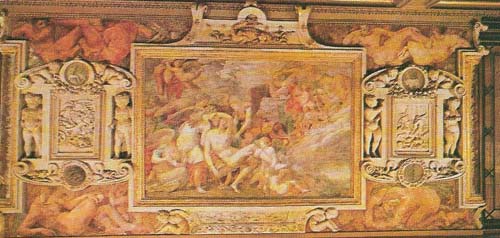
Figure 1. Rossi Florentino’s section of the Galerie Francois Ier (1535–1539) in the Chateau de Fontainebleau is one of 12 bays on the gallery, each different. In General, the subjects appear to be allegories of the reign of Francis I. The central fresco here – one of those most likely to be by Rosso’s own hand – is the “Death of Adonis”, which may refer to the death of the dauphin in 1536. The salamander is above the king’s personal emblem. A similar mixture of painting and stucco – Roman and Florentine ideas – was used by Primaticco.
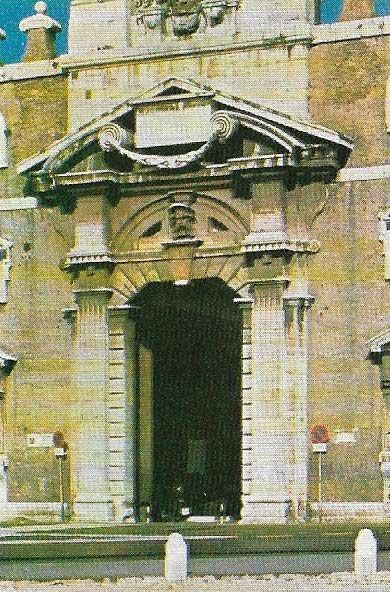
Figure 2. Michelangelo’s Porta Pia, Rome, begun in 1561, is a fine example of mannerist license. There are no true capitals and the pseudo-capitals are fragments of an architrave topped by the guttae of a frieze.
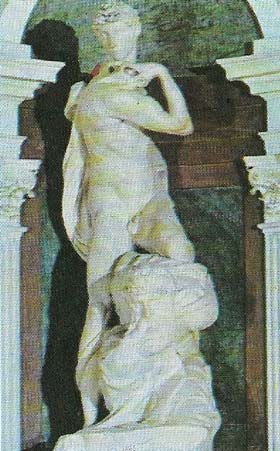
Figure 3. Michelangelo's "Victory" (c. 1527–1528) was designed to stand in a niche in the lowest zone of the tomb of Julius II to be flanked by a pair of slaves. The continuous spiral movement of the figures is known as the figura serpentinata (snake-like figure) which Michelangelo is said to have thought most perfect.
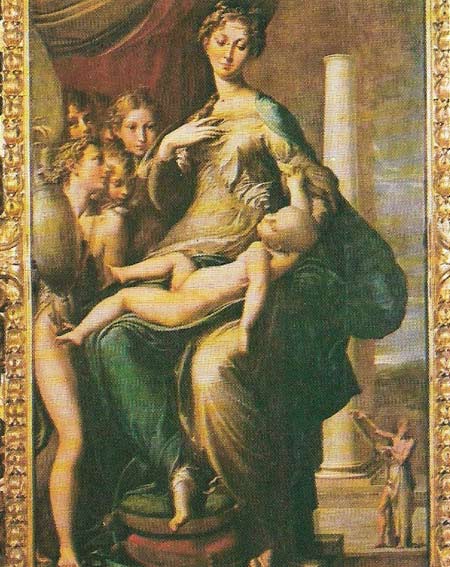
Figure 4. Parmigianino’s “Madonna with the Long Neck” (1534–1536) was painted for Elena Baiardi, for a church in Parma. The subject refers to St Helen’s vision of the Cross, represented in the crystal vase. All the figures react to this vision – the Virgin by seeing in the child across her knees a prefiguration of the Passion. The column is a symbol of the Virgin’s purity. The content is comparable to that of an altarpiece by Correggio (c. 1494–1534), but the ecstasy seems more stylish than expressive, and strikingly elegant in form.
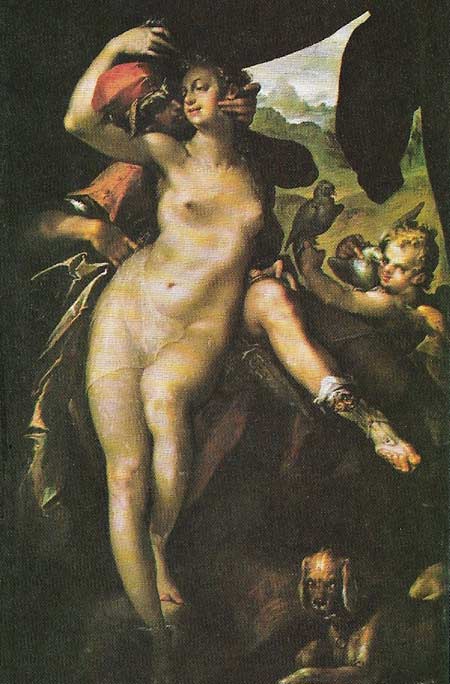
Figure 5. Bartholomaus Spranger’s “Venus and Adonis” (c. 1590) was characteristic of the taste of Rudolph II and his court at Prague, where there was an unusual interest in all things strange and improbable. Spranger was a cosmopolitan artist, trained in Antwerp, Paris, Parma and Rome, who exerted great influence in the last stages of Mannerism through his engraver Goltzius. In general he gives the impression, as here, of finding his style as absurd as his subjects.
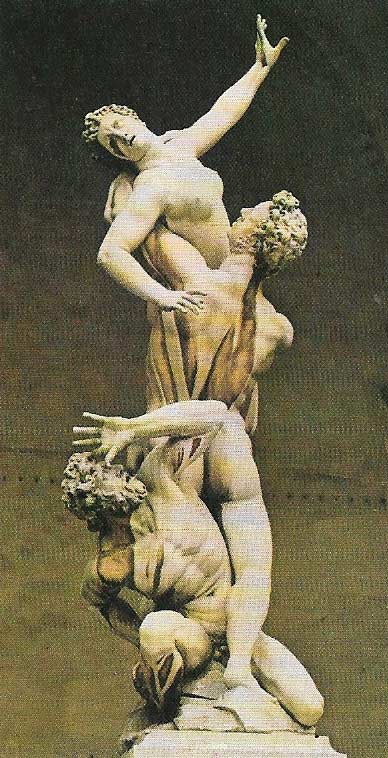
Figure 6. Gianbologna’s “The Rape of the Sabine” (1582) seems to have been made without the artist having in view a subject, a site or a patron, but only the ambition to show the world that, contrary to rumor, he could work as well on a colossal scale in marble as in small bronzes (on which he made his reputation). He believed that he had made his task as difficult as possible by multiplying the figures and by varying their age and sex. The piece’s title was arrived at when the work was complete.
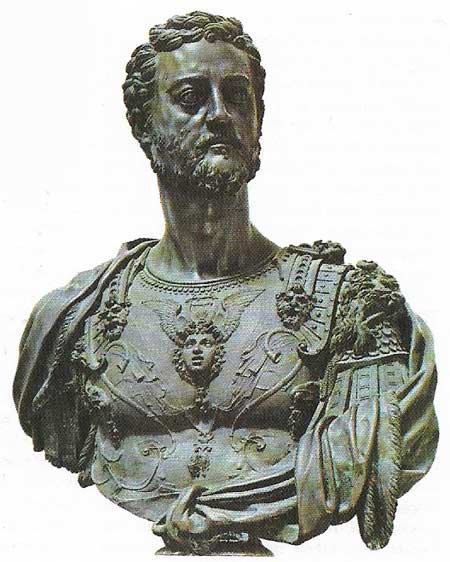
Figure 7. Cellini's bronze bust of Duke Cosimo I of Florence was made between 1545 and 1547. Cosimo was a Medici who was created Grand Duke of Tuscany in 1569. He was a great art-lover and Cellini's Parton.
The High Renaissance style in Florence and Rome had been in many ways artificial, most obviously in its grace, idealism and tendency to exaggerated posturing. The achievement of the major artists was a perfect style, or so it seemed; and the pursuit of perfect style was to become an end in itself. The phase so characterized is called Mannerism (from maniera, Italian for "style").
Qualities of style
Artifice was not the only quality of style felt worthy of further cultivation; novelty, licence, variety, and the esoteric were appreciated in the sixteenth century – in the criticism of Giorgio Vasari (1511–1574), for example – as never before and the demonstration of artistic genius was thought a legitimate object in a work of art. This demonstration could become the work's true subject. Mannerism was a late Renaissance style and it was important that all the beliefs on which it was based could be justified by selective reading of ancient authorities. But the surviving monuments of antiquity were studied in a new spirit, paying particular attention to license, complexity, and grace. In northern countries the appreciation of similar qualities in late Gothic art facilitated the reception of the new style, but Gothic as such was held in contempt and what was supplied was of classical breeding.
The phenomenon of Mannerism did not occur everywhere – Venice, for example, was almost immune – and its arrival was never marked by a sharp break but by a shift of emphasis. Qualities such as grace appear in many stages in Renaissance art and were generally subject to inflation across the period; in some centers, as art looked inward at itself and not outward at nature, an extra twist of the spiral produced hyperinflation. This first happened in Rome; and perhaps it had already happened by 1520 in the work of Raphael and Michelangelo.
Artistic conditions in Rome soon after 1520 were ideal for the growth of Mannerism. A brilliant group of young artists, the pupils of Raphael, Florentines such as G. B. Rosso (Rosso Fiorentino, 1494–1540) and Benvenuto Cellini (1500–1571), and north Italians such as Girolamo Parmigianino (1503–1540), were impelled toward the display of virtuosity by their own competitive situation, by the qualities of the last works of Raphael (died 1520), and by the current work of Michelangelo (1475–1564). The latter's drawings were rich in invention, his sculpture suave and refined away from the natural, his architecture increasingly more marked by license than by rule (Figures 2 and 3). The dispersal of this group had begun before the sack of Rome in 1527, but that event was directly effective in the spread of Mannerism, through Perino del Vaga (c. 1500–1547) to Genoa, through Parmigianino to Emilia, and through Rosso, eventually, to Fontainebleau. Furthermore, the Mannerist style was unusually accessible because so much of it appeared in engravings.
Medici patronage
In Italy the most impressive Mannerist in the 1530s, if Michelangelo is excepted, was certainly Parmigianino, first in Bologna and then in Parma. His "Madonna with the Long Neck" (Figure 4) is one of a number of religious works whose spiritual message is less obvious than their elegant forms, rhythmic grace, refinement of detail, and airless, unreal color. After 1540, Florence became the most vital Italian center and remained so until the early 17th century under the patronage of the Medici dukes. Cosimo I (1519–1574) assembled a team of highly talented artists: the painters Salviati (1510–1563) and Il Bronzino (1502–1572), the sculptors Cellini (Fig 7) and Bartolommeo Ammanati (1511–1592), and the architect Buontalenti (1536–1608). To this court and its new nobility was attracted, in about 1560, the one really great artist who worked wholly in the Mannerist style – the Fleming Gianbologna (1529–1608). No sculptor's work has ever been so suavely complex, nor made so purposefully to be admired for its art. He brought the bronze statuette to perfection but, partly in emulation of Michelangelo, worked also on a large scale in marble (Figure 6).
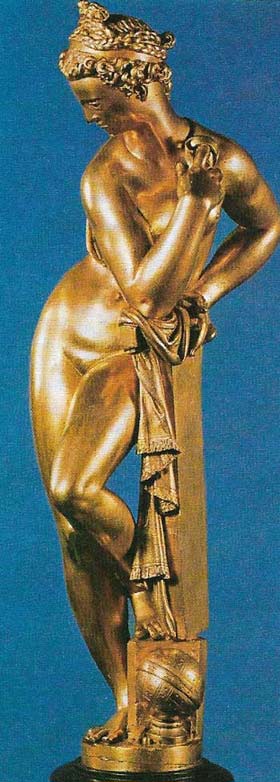 |
| Gianbologna’s “Astronomy” (c. 1573) is one of the most highly finished of this artist’s statuettes and was made to be turned round in the hand so that the brilliance and variety of its composition could be admired. From any angle the forms make a balanced and complicated design, each one different. In his work Gianbologna took a characteristic aspect of the 16th century – making art for connoisseurs – to its logical conclusion. He believed that the subject was of no particular significance, the figures being chosen “to give scope to the science and accomplishment of art”. |
It is natural that a style that tended to preciosity and rested upon technical accomplishment should flourish in metalwork and jewelry; Cellini, whose gold saltcellar was completed for Francis I, was the most famous goldsmith of the period, but the richest concentration of talent was in south Germany in the second half of the century.
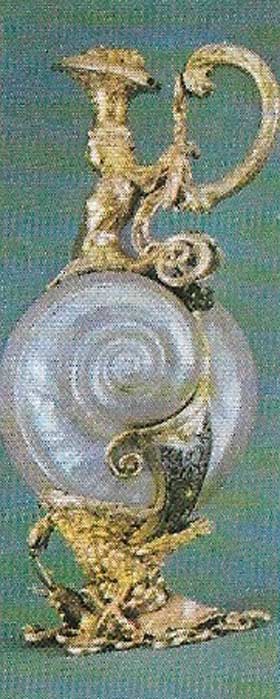 |
| Wensel Jamnitzer’s ewer (c. 1570) is made of silver gilt, enamelled and inlaid. Vases of surprising fantasy, in bronze and silver, survived from the Roman Empire. Thereafter, the creation of more witty and complex tableware was a main Mannerist preoccupation. Jamnitzer (1508–1585) used casts of real animals. |
Northern centers
Centers of Mannerism in the north were mainly, but not exclusively, at courts, and the first of these was at Fontainebleau. There, from about 1530, the decoration of Francis's new chateau was emphatically Mannerist, and very influential (for example, in England). The principal artists there were Italian – Rosso and Primaticcio – and their main work was the Galerie Francois Ier, an exuberant mixture of stylized allegorical painting and complex stucco relief (Figure 1) where first appeared the universal currency of Mannerist decoration, strapwork (ornamental strap-like bands). Around 1600 the last vital centers of Mannerism were in Holland (the school of Haarlem) and at the court of Rudolph II at Prague, where the Flemish painter Bartholomaus Spranger (1546–1611) and the Dutch sculptor Adriaen de Vries (c. 1548–1626) produced decadent, erotic art of the highest order.
